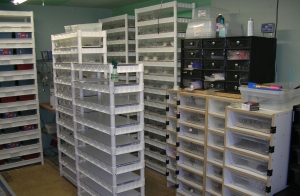10 Tips for Constructing a Ball Python Room
By Justin Kobylka and Sebastian Walker
Originally published: Fall 2013
Last updated: December 20, 2022
At some point, every reptile keeper dreams about building a reptile room. The ability to design a space just right for you and your collection is an exciting prospect filled with endless possibilities.
The specifics of layout and construction will be unique to each collection; however, there are several key factors to consider that even experienced breeders overlook.
- Ensure that you have enough power coming into your property. Many houses still only have a 100A supply, which may not be enough to cover the needs of your home and your reptile room. You don’t want your Ball Python room tripping because you used the microwave.
- Install a backup power source or a plan of action in the event of a complete power failure. One option is an autostart generator that can completely power the building. A more economical option is a manual backup generator that can maintain only the critical systems. Remember to store plenty of fuel in case of an extended outage. You should also have multiple alert systems in place should power failure occur.
- Have backup thermostats for everything linked to the electricity, including all heating and cooling. Thermostats are the most simple and critical lines of defense between killer temps and your Ball Pythons. Make sure to consult a qualified electrician for all electrical work.
- Completely seal and waterproof your floor. Ensure the seal goes 6 inches up the wall. Include a drain in the room if you can afford it. Spills will be much easier to contain and clean up.
- If possible, always make the room a bit bigger than you think you need, even though it may cost a little more to construct and heat. Make sure you allocate enough space for work areas other than animal housing, such as an extra sink, storage, or photography area if needed. Those dedicated spaces can save massive amounts of time and money long-term. Adding 20% extra square footage does not increase the budget by 20%. Not being cramped is well worth the additional funds!
- Think of time-motion studies when laying out your room. A lot of time is spent undertaking repetitive weekly/daily tasks in a reptile room. With some careful layout planning, you can reduce the amount of time you spend undertaking these repetitive tasks. This can add up to extensive time saved over the months and years.
- Include a quarantine space. Even herpers with the highest standards of care deal with sickness and all new acquisitions should be thoroughly vetted to prevent risk to your collection. You want these animals physically separated from your main collection, so don’t forget to plan accordingly.
- Consider the most difficult, time-consuming way to build your room – and do it that way. Take the short-term pain for long-term gain. Have the floor properly screeded and leveled, address the dampness in your basement, install those extra power sockets, and upgrade your house to 200A or 300A. You will thank yourself later.
- Anticipate complications. Make a list of everything that can go wrong with your room and find a way to manage that risk by either accepting it or devising a solution to eliminate or reduce it. Don’t let problems catch you by surprise.
- Plan, plan, plan. Time spent upfront in planning comes back 100-fold over the life of the room. Everyone makes mistakes, but the fewer retroactive adjustments you have to make to the room, the better.


